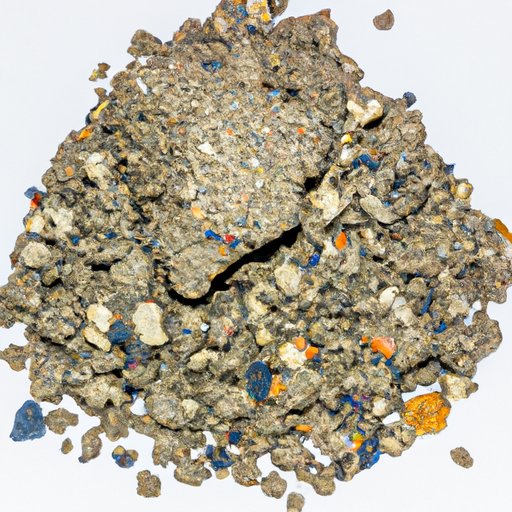
I. Introduction
Rock enthusiasts, collectors, and anyone who spends time outdoors might encounter the problem of dirty, grimy, and stained rocks. Cleaning rocks is necessary not only for aesthetic purposes but also for preserving their quality and health. Different types of rocks, such as sedimentary, igneous, or metamorphic, might require different cleaning methods to avoid damage and preserve their unique features and minerals.
II. Step-by-step guide to cleaning rocks
Cleaning rocks requires simple supplies that are usually available at home or can be purchased from a hardware store. Some of these essential supplies include:
- Bucket
- Scrub brush or soft-bristled brush
- Mild detergent or dish soap
- Water hose or source of running water
To clean different types of rocks, follow these steps:
- Prepare a cleaning solution by mixing mild detergent or dish soap with water in a bucket.
- Dip the scrub brush or soft-bristled brush into the cleaning solution and gently scrub the rock’s surface.
- Rinse the rock with water using a water hose or running water source. (Avoid using high-pressure water as it can damage some rocks.)
- Repeat the scrubbing and rinsing process as necessary until the rock is clean.
To avoid damaging the rocks, it is necessary to take precautions, including:
- Avoid using harsh cleaners, acidic solutions, bleach, or other corrosive substances that can alter the color or texture of the rocks.
- Use a soft-bristled brush for porous or delicate rocks to avoid scratching or damaging the surfaces.
- Wear gloves to avoid contact with harmful or toxic substances, such as oil or chemicals found on some rocks.
III. DIY cleaning solutions for rocks
Natural cleaning solutions are an excellent alternative to commercial cleaners for those who prefer eco-friendly and affordable options. Some natural ingredients that can be used for cleaning rocks include:
- Vinegar
- Baking soda
- Lemon juice
- Hydrogen peroxide
Here are some easy and effective recipes for cleaning solutions:
- Vinegar solution: Mix equal amounts of water and vinegar in a bowl. Dip a soft-bristled brush into the solution, and scrub the rock’s surface. Rinse with water.
- Baking soda paste: Mix baking soda and water in a bowl to form a thick paste. Apply the paste to the rock’s surface and let it sit for a few minutes. Scrub with a soft-bristled brush and rinse with water.
- Lemon juice and salt: Combine lemon juice and salt to form a paste. Apply the paste to the rock’s surface and let it sit for a few minutes. Scrub with a soft-bristled brush and rinse with water.
- Hydrogen peroxide: Mix a small amount of hydrogen peroxide with water in a bowl. Dip a soft-bristled brush into the solution, and gently scrub the rock’s surface. Rinse with water.
When using these solutions, it is important to take the necessary precautions, including:
- Wearing gloves and eye protection when handling acidic or harsh substances
- Testing the solution on a small, inconspicuous area first to avoid damaging the rock’s surface
IV. Specialized cleaning tools for rocks
Specialized cleaning tools are available for those who want more efficient and targeted cleaning. These tools include:
- Scouring pads or abrasive sponges
- Wire brushes or toothbrushes
- Ultrasonic cleaners
Depending on the type of rock and the level of cleaning required, certain tools might work better than others. For example, ultrasonic cleaners are ideal for cleaning delicate rocks or those with intricate crevices, while scouring pads work well for rough and tough rocks. However, some precautions must be taken when using specialized cleaning tools:
- Avoid using wire brushes or abrasive sponges on soft, porous, or delicate rocks as they can scratch or damage the rock’s surface.
- Follow the manufacturer’s instructions when using ultrasonic cleaners to avoid damaging the rock’s texture or structure.
- Wear gloves and eye protection when using abrasive or acidic solutions with specialized cleaning tools.
V. Safety measures when cleaning rocks
Cleaning rocks can be a strenuous and potentially dangerous activity, especially when dealing with heavy, sharp, or toxic rocks. Some safety measures to consider include:
- Using proper lifting techniques when handling or moving heavy rocks (e.g., bending at the knees, not lifting above shoulder height)
- Wearing gloves and safety goggles when handling sharp or toxic rocks
- Keeping the work area clean and organized to avoid tripping or falling
- Storing cleaning solutions and supplies away from children or pets.
VI. Cleaning decorative rocks
Decorative rocks, such as those used in landscaping or aquariums, require special care to maintain their appearance and quality. Some tips for cleaning decorative rocks include:
- Removing dirt and debris regularly using a soft-bristled brush or vacuum cleaner
- Using natural cleaning solutions or a mild soap solution for tough stains
- Rinsing the rocks thoroughly and air-drying them before replacing them in the aquarium or landscaping
- Monitoring the rocks’ appearance regularly and replacing them if they start to degrade or lose color.
VII. Conclusion
Cleaning rocks might seem like a daunting task, but with the right tools, materials, and methods, it can be simple, effective, and even enjoyable. By following these tips and guidelines, you can clean and maintain your rocks for years to come.
For more information or resources on rock cleaning and preservation, check out online forums, blogs, and local rock shops.




